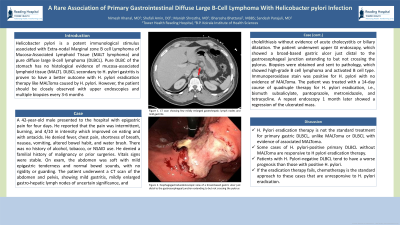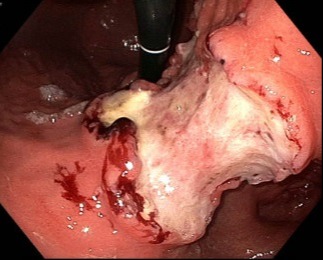Tuesday Poster Session
Category: Stomach
P4202 - A Rare Association of Primary Gastrointestinal Diffuse Large B-Cell Lymphoma With Helicobacter pylori Infection
Tuesday, October 24, 2023
10:30 AM - 4:00 PM PT
Location: Exhibit Hall

Has Audio

Nimesh Khanal, MD
Tower Health-Reading Hospital
West Reading, PA
Presenting Author(s)
Nimesh Khanal, MD1, Shefali Amin, DO, MSEd2, Manish Shrestha, MD3, Bharosha Bhattarai, MBBS4, Salina Munankami, MBBS5, Sandesh Parajuli, MD6
1Tower Health-Reading Hospital, West Reading, PA; 2Reading Hospital, Reading, PA; 3Reading Hospital, West Reading, PA; 4B.P. Koirala Institute of Health Sciences, Dharan, Kosi, Nepal; 5Kathmandu Medical College and Teaching Hospital, Kathmandu, Bagmati, Nepal; 6Tower Health-Reading Hospital, Reading, PA
Introduction: Helicobacter pylori is a potent immunological stimulus associated with Extra-nodal Marginal zone B cell Lymphoma of Mucosa-Associated Lymphoid Tissue (MALT lymphoma) and pure diffuse large B-cell lymphoma (DLBCL). Pure DLBC of the stomach has no histological evidence of mucosa-associated lymphoid tissue (MALT). DLBCL secondary to H. pylori gastritis is proven to have a better outcome with H. pylori eradication therapy like MALToma caused by H. pylori. However, the patient should be closely observed with upper endoscopies and multiple biopsies every 3-6 months.
Case Description/Methods: A 42-year-old male presented to the hospital with epigastric pain for four days. He reported that the pain was intermittent, burning, and 4/10 in intensity which improved on eating and with antacids. He denied fever, chest pain, shortness of breath, nausea, vomiting, altered bowel habit, and water brash. There was no history of alcohol, tobacco, or NSAID use. He denied a familial history of malignancy or prior surgeries. Vitals signs were stable. On exam, the abdomen was soft with mild epigastric tenderness and normal bowel sounds, with no rigidity or guarding. The patient underwent a CT scan of the abdomen and pelvis, showing mild gastritis, mildly enlarged gastro-hepatic lymph nodes of uncertain significance, and cholelithiasis without evidence of acute cholecystitis or biliary dilatation. The patient underwent upper GI endoscopy, which showed a broad-based gastric ulcer just distal to the gastroesophageal junction extending to but not crossing the pylorus. Biopsies were obtained and sent to pathology, which showed high-grade B cell lymphoma and activated B cell type. Immunoperoxidase stain was positive for H. pylori with no evidence of MALToma. The patient was treated with a 14-day course of quadruple therapy for H. pylori eradication, i.e., bismuth subsalicylate, pantoprazole, metronidazole, and tetracycline. A repeat endoscopy 1 month later showed a regression of the ulcerated mass.
Discussion: H. Pylori eradication therapy is not the standard treatment for primary gastric DLBCL, unlike MALToma or DLBCL with evidence of associated MALToma. However, some cases of H. pylori-positive primary DLBCL without MALToma are responsive to H pylori eradication therapy. Patients with H. Pylori-negative DLBCL tend to have a worse prognosis than those with positive H. pylori. However, if the eradication therapy fails, chemotherapy is the standard approach to these cases that are unresponsive to H. pylori eradication.

Disclosures:
Nimesh Khanal, MD1, Shefali Amin, DO, MSEd2, Manish Shrestha, MD3, Bharosha Bhattarai, MBBS4, Salina Munankami, MBBS5, Sandesh Parajuli, MD6. P4202 - A Rare Association of Primary Gastrointestinal Diffuse Large B-Cell Lymphoma With Helicobacter pylori Infection, ACG 2023 Annual Scientific Meeting Abstracts. Vancouver, BC, Canada: American College of Gastroenterology.
1Tower Health-Reading Hospital, West Reading, PA; 2Reading Hospital, Reading, PA; 3Reading Hospital, West Reading, PA; 4B.P. Koirala Institute of Health Sciences, Dharan, Kosi, Nepal; 5Kathmandu Medical College and Teaching Hospital, Kathmandu, Bagmati, Nepal; 6Tower Health-Reading Hospital, Reading, PA
Introduction: Helicobacter pylori is a potent immunological stimulus associated with Extra-nodal Marginal zone B cell Lymphoma of Mucosa-Associated Lymphoid Tissue (MALT lymphoma) and pure diffuse large B-cell lymphoma (DLBCL). Pure DLBC of the stomach has no histological evidence of mucosa-associated lymphoid tissue (MALT). DLBCL secondary to H. pylori gastritis is proven to have a better outcome with H. pylori eradication therapy like MALToma caused by H. pylori. However, the patient should be closely observed with upper endoscopies and multiple biopsies every 3-6 months.
Case Description/Methods: A 42-year-old male presented to the hospital with epigastric pain for four days. He reported that the pain was intermittent, burning, and 4/10 in intensity which improved on eating and with antacids. He denied fever, chest pain, shortness of breath, nausea, vomiting, altered bowel habit, and water brash. There was no history of alcohol, tobacco, or NSAID use. He denied a familial history of malignancy or prior surgeries. Vitals signs were stable. On exam, the abdomen was soft with mild epigastric tenderness and normal bowel sounds, with no rigidity or guarding. The patient underwent a CT scan of the abdomen and pelvis, showing mild gastritis, mildly enlarged gastro-hepatic lymph nodes of uncertain significance, and cholelithiasis without evidence of acute cholecystitis or biliary dilatation. The patient underwent upper GI endoscopy, which showed a broad-based gastric ulcer just distal to the gastroesophageal junction extending to but not crossing the pylorus. Biopsies were obtained and sent to pathology, which showed high-grade B cell lymphoma and activated B cell type. Immunoperoxidase stain was positive for H. pylori with no evidence of MALToma. The patient was treated with a 14-day course of quadruple therapy for H. pylori eradication, i.e., bismuth subsalicylate, pantoprazole, metronidazole, and tetracycline. A repeat endoscopy 1 month later showed a regression of the ulcerated mass.
Discussion: H. Pylori eradication therapy is not the standard treatment for primary gastric DLBCL, unlike MALToma or DLBCL with evidence of associated MALToma. However, some cases of H. pylori-positive primary DLBCL without MALToma are responsive to H pylori eradication therapy. Patients with H. Pylori-negative DLBCL tend to have a worse prognosis than those with positive H. pylori. However, if the eradication therapy fails, chemotherapy is the standard approach to these cases that are unresponsive to H. pylori eradication.

Figure: Broad-based gastric ulcer just distal to the gastroesophageal junction extending to but not crossing the pylorus
Disclosures:
Nimesh Khanal indicated no relevant financial relationships.
Shefali Amin indicated no relevant financial relationships.
Manish Shrestha indicated no relevant financial relationships.
Bharosha Bhattarai indicated no relevant financial relationships.
Salina Munankami indicated no relevant financial relationships.
Sandesh Parajuli indicated no relevant financial relationships.
Nimesh Khanal, MD1, Shefali Amin, DO, MSEd2, Manish Shrestha, MD3, Bharosha Bhattarai, MBBS4, Salina Munankami, MBBS5, Sandesh Parajuli, MD6. P4202 - A Rare Association of Primary Gastrointestinal Diffuse Large B-Cell Lymphoma With Helicobacter pylori Infection, ACG 2023 Annual Scientific Meeting Abstracts. Vancouver, BC, Canada: American College of Gastroenterology.
